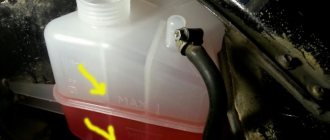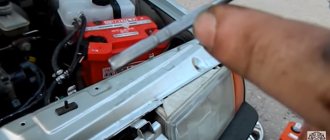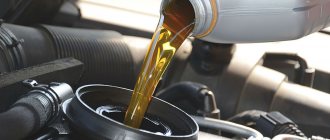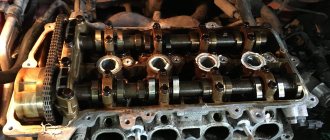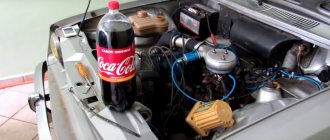Do I need to flush the engine when changing the oil?
Oil performs the function of lubricating the rubbing parts and mechanisms of the internal combustion engine system. With prolonged use, the lubricant loses its original properties and must be replaced. However, not all car enthusiasts know that before changing the oil, it is necessary to flush the engine.
Flushing the engine is an important maintenance step that every car owner faces. Even if the car’s engine is operated directly from the car dealership using the same oil, after 100-120 thousand kilometers a large amount of deposits, sludge, scale and other contaminants will accumulate inside the engine.
All this negatively affects the patency of the oil channels in the engine, overheating of thorn vapors and oil starvation in some engine cylinders is possible. All this will sooner or later lead to expensive major repairs.
What do car enthusiasts think about flushing the engine before changing the oil?
- Do I need to rinse? A clean engine does not require flushing. And it will only damage a contaminated engine faster. You should definitely not use “five-minute” cleaners to clean a dirty engine due to their high activity. As a result, all plaque will begin to peel off in large pieces without dissolving, clogging the oil channels. The result is oil starvation.
- Which is better to use?
I recommend “Laurel”, but a full-fledged composition, not a five-minute one. That is, the entire volume needs to be filled into the oil system. - The importance of proper flushing
I already have my third car, and I still use flushing from Rosneft and Lukoil. I avoid the “Five Minutes” and I don’t recommend it to you. The current owner of my first car has already reached 387 thousand km on the previous engine, he uses the same compounds as I do. The conclusion is this: wash the engine with high-grade detergents.We recommend
“Vibration after replacing engine mounts: causes and methods of “treatment”” Read more
- Advice from experts
The other day I came across the results of testing various additives in a 6-year-old magazine. Thus, the best engine flush before changing the oil turned out to be Energy-3000, filled for 200 km. For greater efficiency, it was also recommended to fill in the flushing oil immediately before changing the regular lubricant. The engine with this mixture should be idle for 5-10 minutes. Moreover, the specific brand of flushing oil was not indicated. - How often to flush the engine?
I usually combine flushing with replacing oil filters, as well as during season changes. During these periods, fluids change most completely. Plus, I spend a liter of fresh oil cleaning the entire system to remove all deposits from the crankcase. The total mileage of the car at the moment is 154 thousand km on the odometer, of which I have driven 49 thousand. In fact, the mileage is most likely even higher, since the car was also driven in Japan as a training vehicle. I use Eneos oil, which I buy at Rosneft gas stations. The engine does not cause any complaints, apart from minor problems that arise in the electrical and fuel parts. My opinion is this: flushing the engine is mandatory at least twice a year.
In what cases is engine flushing necessary?
When purchasing a car, every owner must take care of flushing the engine system and filling with fresh engine oil. Moreover, this process is performed using chemical means in cases where:
- The new owner of the vehicle plans to use motor fluid from another manufacturer.
- Poor quality lubricant was previously used.
- A major overhaul of the internal combustion engine system is being carried out.
- The engine is in a worn-out condition and needs to be flushed to remove solid deposits and carbon deposits.
- The properties of the oil deteriorate when operating in turbocharged internal combustion engines. As a rule, the lubricant in them quickly exhausts its service life.
- Various deposits and debris penetrate into the power unit, especially when it comes to the oil system line.
In other situations, you can use motor oil.
How to flush an engine with flushing oil
While worrying about the cleanliness of the car body, many drivers forget about the condition of the main components. While replacing filters and other consumables is easy, cleaning the engine from carbon deposits will require the intervention of a technician. In order to delay the time of contacting a technician as much as possible, it is necessary to periodically flush the power unit with special oils.
When is flushing necessary?
1. Switch to oil from another manufacturer.
2. Changing the type of lubricant.
3. If water or condensate drops get into the fuel or lubricant.
4. When buying a used car.
5. If excessively contaminated elements are detected.
Benefits of flushing
Not all drivers decide to implement this method of cleaning the power unit, fearing that they may shorten its service life. Such problems will not arise if you choose responsibly.
The use of chemical liquids is beneficial since cleaning takes no more than half an hour. They contain additives that promote rapid breakdown and removal of contaminants.
Using flushing does not cause problems or rapid wear of elements. To do this, it is enough to follow the rules of use established by the manufacturer.
Basic engine flushing issues
Most often, car enthusiasts wonder whether it is necessary to flush the system when filling oil, if the composition being filled remains the same or is completely similar to the previous one.
In this situation, the engine does not need to be flushed, since regardless of the manufacturer, the type and composition of the oil are practically the same. If you use lubricant from another manufacturer, it is recommended to fill it before the replacement interval.
Even when using semi-synthetic fluid and replacing it with synthetic fluid, there is no need to flush the engine. The composition of these oils is almost identical to each other.
However, mechanics do not recommend mixing mineral water and synthetics. They use various types of additives and may cause problems during further operation of the internal combustion engine.
Is it worth using?
The question of whether it makes sense to flush the engine when changing the oil has divided the automotive community. This is a controversial issue, especially in the case of older cars. Some mechanics argue that engine flushes on cars with high mileage, unknown service history, and running on the cheapest mineral oil can do more harm than good. In such installations, deposits are considered beneficial because they clog leaks that form, for example, due to rotting gaskets or separating parts.
Opponents of this approach respond that if there are leaks in the engine, they must be fixed. Before doing this, flush the engine to dissolve at least some of the deposits. Which approach is correct? We will answer as mechanics usually do: it depends, first of all, on how much you can spend on repairing a worn-out engine. If there is a lot, start working by removing deposits.
But there is another argument for not using engine rinses in old, heavily worn cars. The effect of such measures is based on mitigating precipitation. Fragments that fall from the walls of contaminated components will be removed from the system along with the engine oil. However, it is likely that some of them will remain in the engine and severely contaminate the new lubricant. This may cause the oil filter to become clogged. After flushing, always monitor the condition of the lubricant and, if necessary, replace it.
I hope we helped you determine which engine flush is best and you understand whether you really need it. We recommend using it, since the average price of such a product is 400-500 rubles, and it will bring you much more benefits.
Source
What is the engine washed with?
There are many options for flushing engines, including:
- Diesel fuel (diesel fuel);
- Dimexide.
- New or flushing oil.
- Various specialized products, chemical reagents.
- Cleaning the engine during complex disassembly or using accelerated technology.
Some methods are only feasible in car services, for example, at https://avantage-style.ru, while others are applicable at home. Each driver chooses independently which of the listed options suits him and his car.
How to flush the engine when changing the oil
A good way to clean the engine system is to use new oil for flushing. To complete this procedure you must purchase:
First of all, the waste is drained. To perform this process, you need to warm up the engine to operating temperature and turn it off. In this case, all remaining motor fluid should drain. For best results, it is recommended to perform this work on a lift.
- After draining is completed, the oil is replaced and a new oil filter is installed.
- Next, you should turn on the engine and leave it to run for 15-20 minutes, or the car will travel 300-500 kilometers.
- The oil is drained again and replaced with a new, good one, on which the car is supposed to be used further.
For several days you should not overload the engine system; it is advisable to drive at medium speeds.
The next replacement is carried out upon reaching 5 thousand km.
This washing technique guarantees safe cleaning of the internal combustion engine from toxins, oil residues and other contaminants. In this case, there is no need to use chemical reagents that can negatively affect the mechanisms of the internal combustion engine system.
The effect of such washing is achieved due to the presence of detergent additives in the oil. Answering the question of what kind of oil to flush the engine with, we can say that any oil that contains a large amount of detergent and dispersant additives is suitable for this.
How long should the engine run on flushing oil?
Flushing oils, unlike five-minute products, consist of a complete mineral base and a special package of additives. This package reduces the number of protective, extreme pressure and anti-friction properties (which constitute the main cost) and increases the content of calcium components. Additionally, surfactants have been added to the cleaning oils, enhancing the cleaning effect. Therefore, flushing oils have an off-scale alkalinity number.
Most instructions for flushing oil recommend that after filling it, let the engine idle for 10 to 30 minutes. After this, you need to drain this oil, change the filter and refill with regular lubricant.
And the engine on flushing oil should run exactly as much and exactly in the same mode as indicated in the instructions. If it is written that the engine should run at idle, you cannot add speed, much less drive a car. Also, you cannot exceed the regulated period of work. This will not help clean the engine better. But it can cause damage to the engine.
But if the manufacturer allows driving with flushing oil, this can and even should be done. You just need to carefully read the instructions and do not exceed the permissible speed, load or mileage.
Is it possible to flush the engine with diesel fuel?
Using diesel fuel as a means to flush the oil system has both disadvantages and advantages. This method has been used for a very long time, and may well be considered “old-fashioned”.
The fact is that diesel fuel has excellent cleaning properties, which are an order of magnitude better than gasoline. In addition, it can lubricate channels and ducts in the engine lubrication system. Diesel fuel has this effect due to the large amount of sulfur it contains.
The popularity of diesel fuel as a flushing agent is due not only to its good properties, but also to the fact that in the past there was not much to choose from, and drivers used any suitable means at hand. However, diesel fuel shows good properties even in our time.
But despite all the positive qualities, diesel fuel also has several disadvantages. This is primarily due to the possibility of using low-quality diesel fuel.
What and when to wash
In absolutely every internal combustion engine, resin deposits form: during engine operation, the lubricant oxidizes, forming a varnish film on the parts of the lubrication system. Other contaminants stick to this film - products of incomplete combustion of fuel, wear of mechanisms, etc. Over time, the films turn into solid deposits. It’s not every day that we can look inside the engine, but the nature of the processes of deposit formation can be observed in everyday life. Almost every grandmother has a special frying pan that she never washes, and over time a layer of soot of several millimeters forms on its walls. This layer of carbon deposits no longer softens under the influence of temperature; on the contrary, heat only strengthens it.
Now imagine what happens inside a dirty engine. The lubrication cycle of the motor is disrupted, and parts begin to wear out faster. Additionally, deposits can flake off, which can lead to serious damage.
Particularly dangerous are deposits accumulated in the pressure reducing valve of the oil supply pump, hydraulic tensioners of the gas distribution mechanism drive and hydraulic compensators, as well as on the oil intake screen. Even minor contamination of these elements can cause operational problems or instantly damage the motor.
The additives in the engine oil itself are designed to combat these contaminants. Many manufacturers state this on the packaging, making allowances for “normal” operating conditions. Each motorist decides for himself how to determine this criterion, most often without taking into account frost, traffic jams, and annual mileage. Often, the oil cannot withstand the load, begins to burn, and tar deposits appear in the system.
The most important task of flushing is to remove deposits accumulated in the engine. LAVR offers an effective solution for this - adding the drug to old oil that has lost its detergent properties.
Flushing with dimexide
This product has been used as a flush for the internal combustion engine of a car relatively recently. It is not used in its pure form, but exclusively together with the small one, dissolving in it.
It is also important to note that before using dimexide, it is necessary to remove heavy sludge deposits, paint, etc. from the inside of the pan and valve cover.
This must be done due to the fact that dimexide will certainly “raise” these deposits into suspension and they can clog the fine mesh of the oil receiver.
Dimexide should be poured exclusively into a hot engine, since its flushing properties appear only when it is hot. The washing mixture with dimexide is prepared at the rate of 300 ml of liquid per 4 liters of oil.
You can use the cheapest lubricant, because... after mixing with dimexide, it is not suitable for reuse even in a lawn mower. The engine with the flush filled should be allowed to run for 15-20 minutes, after which the oil should be replaced with new oil and be sure to change the oil filter.
Proper engine care is one of the most important tasks in car maintenance. Every owner who is attentive to his car knows that the performance of the car as a whole depends on the quality of service and functionality of the engine. Many car owners, when the time for scheduled maintenance of the car approaches, drive it to a service center, where specialists carry out all the necessary procedures in accordance with the regulations, however, there are also those who prefer to carry out simple service work on their own. In this article we will talk about the procedure for flushing the engine when changing the oil, the need for which has some controversy regarding the frequency of such a process and the type of flushing fluid. Let's consider whether flushing the engine with diesel fuel before changing the oil, which was used in ancient times and remains relevant today, is justified, let's talk about the advantages and disadvantages of this method of dealing with deposits in the power unit, and also tell you how to correctly carry out this procedure.
Brief history
In Russia. The first indirect evidence that the engine needs flushing is the very fact that such liquids appeared in the late 1960s and early 1970s simultaneously in the USSR and the West. In the Soviet Union, internal combustion engine flushing was invented to clean low-speed diesel locomotive engines, and the product for this procedure itself was mineral oil, which was equipped with enhanced detergent additives. The cleaning process was quite long - more than 30 minutes. Then this method was transferred to passenger vehicles without any changes - they began to produce flushing oils, which were then sold very successfully.
But this method had significant drawbacks:
- Quite a lot of non-draining oil residues from the flushing oil settled inside the engine;
- Manufacturers skimped on the components of the composition, because the products posed a danger to highly accelerated engines.
In the West. Western companies have chosen a different path. Economists considered the use of oil products for flushing unprofitable: they had to pay twice - for the oil, and also for its disposal. Therefore, they developed a special technology for using flushing liquids, the descendants of which we know today as express flushes.
Why do you need to flush the engine with diesel fuel?
The fact that it is necessary to change the engine oil according to the regulations is known to all car owners; it is explained by the loss of the lubricant’s protective properties during operation and a decrease in the efficiency of its operation. Many articles have been written about the regulations and the need to change the lubricant in the engine, however, it is rarely mentioned that before adding new lubricant it is necessary to wash the unit from the inside. How do professionals explain this need, and how often should the procedure be performed?
The need to flush the power unit arises in the following situations:
- Changing the type of engine oil. Today, the market for fuels and lubricants is very diverse, which provokes consumers to select more effective oils for their car, which differ not only in type, but also in composition. When draining the oil, even if the procedure is carried out very efficiently, a small amount of waste fluid remains in the units of the unit and on its walls, and when filling the system with new lubricant, a “conflict” may occur between the components of the motor oils, which will negatively affect the operation of the engine.
- Changing the oil after purchasing a car on the secondary market. A similar situation in which the owner knows what kind of fluid is in the engine only from the words of the seller. Before filling the engine oil, the engine must be cleaned of previous lubricant.
- Coolant entering the system as a result of gasket deformation.
- Engine overhaul. In this case, all structural components underwent contact cleaning and were manually assembled, which is often accompanied by the entry of small particles into the system, which can negatively affect the operating life of the unit.
These precedents necessitate mandatory flushing of the power unit. In addition, flushing the engine may be necessary if the car is operated in extreme or difficult conditions, high-speed and high-temperature conditions, which provokes the formation of scale on the internal surfaces of the unit, which blocks the oil passages. You can determine the need to flush the engine by inspecting the drained liquid: if there are large particles, flakes and sludge in the waste, you will need to clean the engine from the inside in order to remove components that are dangerous to the engine.
Nowadays, service center employees recommend flushing with special liquids that are designed to clean the power unit before changing the oil. Why then did the question of flushing with diesel fuel arise? Several decades ago, the number of cars on the country’s roads was much smaller, and not every family could boast of a personal car, and accordingly, the range of fluids for servicing the engine was limited to several types of oils and diesel fuel as a means for washing it. Today the market situation has changed, but the habit remains. Many car owners still wash their engines with diesel fuel themselves and recommend this procedure to others. Moreover, some explain this fact by savings, while others indicate the high efficiency of diesel fuel as a flushing liquid.
Today, the theory about the high usefulness and quality of engine flushing with diesel fuel has both adherents and opponents, and in almost equal quantities, which forces car owners to understand for themselves the pros and cons of such a procedure, and as a result, make an independent decision in favor of a flush emulsion - choose a modern liquid or give preference to diesel fuel.
Replacement required
During operation, the motor becomes overgrown with deposits. High-quality motor oils have cleaning properties, so when replaced in a timely manner, most of the contaminants are washed away naturally. As a result, you should not pay attention to the color of the engine oil. Dark doesn't mean bad. Clear signs of problematic oil:
- it is thick and has lost its fluidity;
- or, conversely, liquid, resembling water.
In this case, urgent flushing and oil change are required, but before starting work, you need to find out the reasons. Loss of quality may be due to a violation of maintenance regulations, the use of low-quality/counterfeit oil, or a technical malfunction - for example, antifreeze getting into the oil. An accurate diagnosis can be made by experts from the FAVORIT MOTORS Group dealership center, who have undergone special training and have a full set of equipment.
Pros and cons of diesel fuel as a flushing fluid
Indeed, one of the advantages of diesel fuel in comparison with special means is the pricing policy. Flushing the engine with diesel fuel before changing the oil will be much cheaper than carrying out this procedure using purchased emulsions. The second argument in favor of diesel fuel is its use in all CIS countries for cleaning engines of domestically produced equipment, as well as its applicability for engines of special equipment. The effectiveness of this method is proven by the large number of domestically produced cars on the roads at the present time, which perfectly perform their functions despite their advanced age.
The process of flushing the engine with diesel fuel
If, after weighing all the pros and cons, you decide to clean the engine with diesel fuel, you trust more in the experience of your ancestors, which has proven its effectiveness over the years, than in modern liquids, we will tell you how to carry out this procedure correctly and correctly. The methodology for flushing the engine with diesel fuel when changing the oil is not particularly complicated or requires significant investment. To complete this task, you will need to stock up on diesel fuel, in a volume of at least eight liters, two oil filters, one of which must be of high quality, preferably an original element for your car, the other can be the cheapest, since it will only be used when cleaning the power unit.
The procedure is carried out immediately after draining the used oil. It is recommended to drain the waste in a pit or overpass, on a warm engine, through the oil drain hole on the crankcase pan. Sometimes this will require removing the power unit protection, if it is provided by the vehicle modification. Detailed instructions for changing the fluid in the power unit for a specific car model can be found in the user manual or in articles on this topic on our website. After draining the used motor oil, you need to dismantle the worn-out oil filter and install a purchased filter element in its place.
The further task of the performer is to flush the engine as much as possible from dirt and sludge. To do this, the engine is first cleaned of coarse particles and oil residues by passing diesel fuel through the system. The oil drain hole is left open, and diesel fuel is poured into the filler opening with maximum pressure. It is important to first place a container for the waste liquid under the drain hole. To complete this procedure, you will need about three liters of liquid.
The next step is a better cleaning of the unit components and hard-to-reach areas. For this purpose, the drain opening is closed and diesel fuel is poured in in a volume equal to the amount of motor oil in the car engine. Next, you need to start the car and drive the flushing emulsion through the system, maintaining speed, but without bringing the power unit to operating temperatures. This point is very important, since at high speeds diesel fuel will not be able to cope with the assigned tasks, causing harm to the contacting parts.
After this procedure, the flushing liquid is drained, and the quality of the flowing emulsion is visually monitored. If the diesel fuel comes out too contaminated, with particles of sludge, it is important to carry out this procedure again. Flushing should be carried out until clean fuel begins to flow out of the drain hole, without any impurities in it. At this stage, engine flushing can be considered complete. Next, you should replace the temporary oil filter with a new, original product, tighten the drain cap tightly, having previously cleaned it of dirt and accumulations, and, if necessary, change the seal between the opening and the plug, if it is provided for by the design. The final stage is pouring new motor oil into the vehicle engine. After replacing the lubricating emulsion, it is important to break in the engine - drive the car for about five kilometers in a quiet mode, check the oil level again, if necessary, add it to the level, inspect the butt joints for lubricant leaks.
Methods for flushing internal combustion engines
Not every car owner can afford a trip to a service station to flush the engine. You can choose the most suitable method based on the characteristics of the car. These methods include:
- chemical;
- full-volume;
- soft cleaning method;
- forced;
- manual, which provides for disassembling the engine and cleaning the surface mechanically.
For manual cleaning, use rags and brushes. A significant advantage of the method is that it allows you to inspect parts and identify possible risks.
Let's take a closer look at each of the available cleaning methods.
Chemical method
The chemical method is the easiest, even for a beginner. You won’t have to spend a lot of time on it, and it will require very little financial expenses. A composition containing solvents is used for it. These substances partially dissolve deposits, lift them from the pan, and give them mobility. Using this method regularly with each replacement, you can achieve cleanliness of internal combustion engine parts, which has a positive effect on their wear resistance.
The method is simple: add flushing to the used (old) fluid, start and idle the engine for no more than 15 minutes. Then the waste is drained. Then change the filter and oil.
The chemical method is convenient and effective, but still has one “but”: it is not recommended for use on heavily contaminated power units.
Gentle cleaning
Full volume cleaning
This method, according to reviews from most motorists, is the highest quality and most effective. The waste liquid is drained through the crankcase, the drain plug is screwed in. The flushing fluid is poured in and the engine is started for 20 minutes. After this time, the flushing is drained through the crankcase, and its residues are removed using a vacuum unit, and only after that the filter and engine fluid are changed.
Forced flushing
Cleaning using this method is carried out with the power unit not working, using a forced circulation device with a container and an additional filter. The actions are:
- after draining the waste, dismantle the filter element;
- the device hose is attached to the filter fitting;
- the second hose is attached to the oil filler neck;
- the third - to the drain pan;
- The washing mixture is poured into the structure’s container.
Under the influence of air pressure, the flushing is supplied to all parts of the lubrication block, carbon deposits and soot settle in the filter. This cleaning takes about an hour. But its result is superior to cleaning by other methods. It is noted that in this way you can get rid of even the most severe deposits of soot and burning. After the forced washing is completed, install the filter and start the unit for 20 minutes.
The disadvantage of this method is the following: after washing, there is practically no oil film left on the surfaces of the parts, and in the initial stage of startup the unit is deprived of lubrication. Flushing the engine at a service station with this method will cost the car owner from 3 to 5 thousand rubles.
Diesel oil and kerosene for washing
Drivers with extensive experience often use methods that have come down from Soviet times: flushing the engine before the next oil change with substances such as diesel fuel and kerosene. The older generation of drivers believe that these types are very effective. But several factors should be taken into account: lubricants and internal combustion engine designs have undergone significant changes since the times of the USSR, and the use of such products in the distant past was justified by the narrow segment of service stations and the lack of a wide range of lubricants.
But it is worth noting that this method also has the right to life in some cases. When completely disassembling the internal combustion engine using kerosene or diesel fuel, it is possible to clean the parts of the unit quite efficiently. But you need to know that this option is suitable for VAZ classics and old-style foreign cars. By pouring these fluids into the oil system of a new car, you will definitely lose the manufacturer’s warranty obligations.
Another nuance when flushing the engine before replacing used oil with new diesel fuel or kerosene is that the remnants of these liquids are an undesirable additive. In general, the procedure is performed according to the following algorithm:
- the engine should be warmed up;
- drain the waste;
- pour diesel fuel or kerosene into the lubrication system (at least 5 liters will be needed). Fill quickly with the lid on the pan open so that the liquid squeezes out the remaining used motor oil. So about 2-3 liters are passed through the system. And then close the plug and pour in an amount of product equal to the usual volume of oil;
- start the engine and accelerate;
- turn off the internal combustion engine for a few minutes ( when the system is filled with the specified fluids, it is unacceptable for the engine to warm up to operating temperatures );
- repeat these steps at least 2 times;
- drain the liquid. If they contain a large amount of soot and soot, the procedure must be repeated;
- replace the filter and lubricant;
- run the power unit for a few minutes so that the remaining flushing fluids are completely dissolved.
The consequences of this cleaning method can be both positive and negative. The first include a decrease in the knocking of hydraulic compensators after the procedure and oil transparency for a long period. On the negative side, there is the possibility of starter problems when cranking the crankshaft, which can make it difficult to start the internal combustion engine.
Let's sum it up
Diesel oil has been used by car owners for many decades as an effective and gentle means for washing the power unit. Today, the effectiveness of the diesel fuel flushing procedure is questioned by many automakers and service center employees; alternatives are considered to be the use of specific liquids to clean the engine. However, a detailed study of the composition of special emulsions for washing the engine raises doubts and controversial issues, since effective removal of soot and dirt using special liquids is achieved due to the presence of aggressive chemical components in them, which can also negatively affect the unit components.
As many years of practice have proven, the method of flushing the engine with diesel fuel has a right to exist, is characterized by high efficiency against the backdrop of low costs, and is considered a gentle way to clean the engine. Each car owner has the right to decide independently which product to choose; however, when performing the flushing, you should act very carefully, follow the instructions, do not overheat the engine - and the result will live up to expectations. Better yet, keep an eye on the engine of your car, try to avoid overheating and stress, change the oil in a timely manner - and the engine will not need such procedures.
This is where the positive aspects of this procedure end. Let's briefly look at the possible negative consequences.
- Lumpy detachment of solid deposits. Sludge build-up accumulates on static surfaces in many motors. Diesel oil can simply separate them from the surface and dump them into a pan. Or run it into the oil channel. Which will cause partial or complete blockage and oil starvation of any friction pair.
- Negative impact on rubber (caoutchouc) and plastic parts. The vast majority of modern seals and retainers in engines made of plastic and rubber are resistant to the chemical effects of any petroleum products. But diesel fuel can completely destroy “tired” non-metallic parts.
- Possible damage to the liners and the formation of scuffing in the ring-cylinder friction pairs. Diesel fuel does not have sufficient viscosity to create any strong protective layer.
All these consequences have the status of probable. And they will not necessarily occur in every individual case.
In what cases should you absolutely not wash your engine with diesel fuel?
There are two cases in which flushing the engine with diesel fuel before changing the oil is more likely to have a negative rather than a positive effect.
- A very tired engine with a lot of output. It is not without reason that some car operating instructions say that after a certain operating time (when the engine wears out and all the gaps in it increase), it is advisable to start filling in thicker oil. This is done to compensate for gaps due to the thicker and more durable oil film created by thick oil. Diesel fuel has a very low viscosity. And even with its short-term use, metal-to-metal contact in all loaded friction pairs will be irreversible. The result is accelerated wear to the limit and a high probability of jamming.
- Modern technological engines. There is no question of using regular oil with the wrong viscosity. And using diesel fuel as a flush at a minimum (even with a single fill) will significantly reduce the service life of the motor.
It is theoretically possible to use diesel fuel as a flushing fluid on engines that are primitive by modern standards (old non-turbocharged diesel engines, VAZ classics, outdated foreign cars).
Reviews from motorists who have tried the diesel fuel flushing method
Good reviews about the method of washing an engine with diesel fuel are mainly left by owners of outdated equipment. For example, drivers often wash ZMZ and VAZ engines with diesel fuel. Here, in most cases, there are no pronounced negative consequences. Although it is not a fact that in one wash the car owner did not reduce the engine life of thousands by 50 km.
You can also find negative reviews on the Internet. For example, after filling with diesel fuel, the engine seized. After disassembly, worn out and twisted liners were discovered.
Therefore, the conclusion about this method of cleaning the engine is this: you can use diesel fuel, but carefully and only on well-preserved outdated engines.
“>
